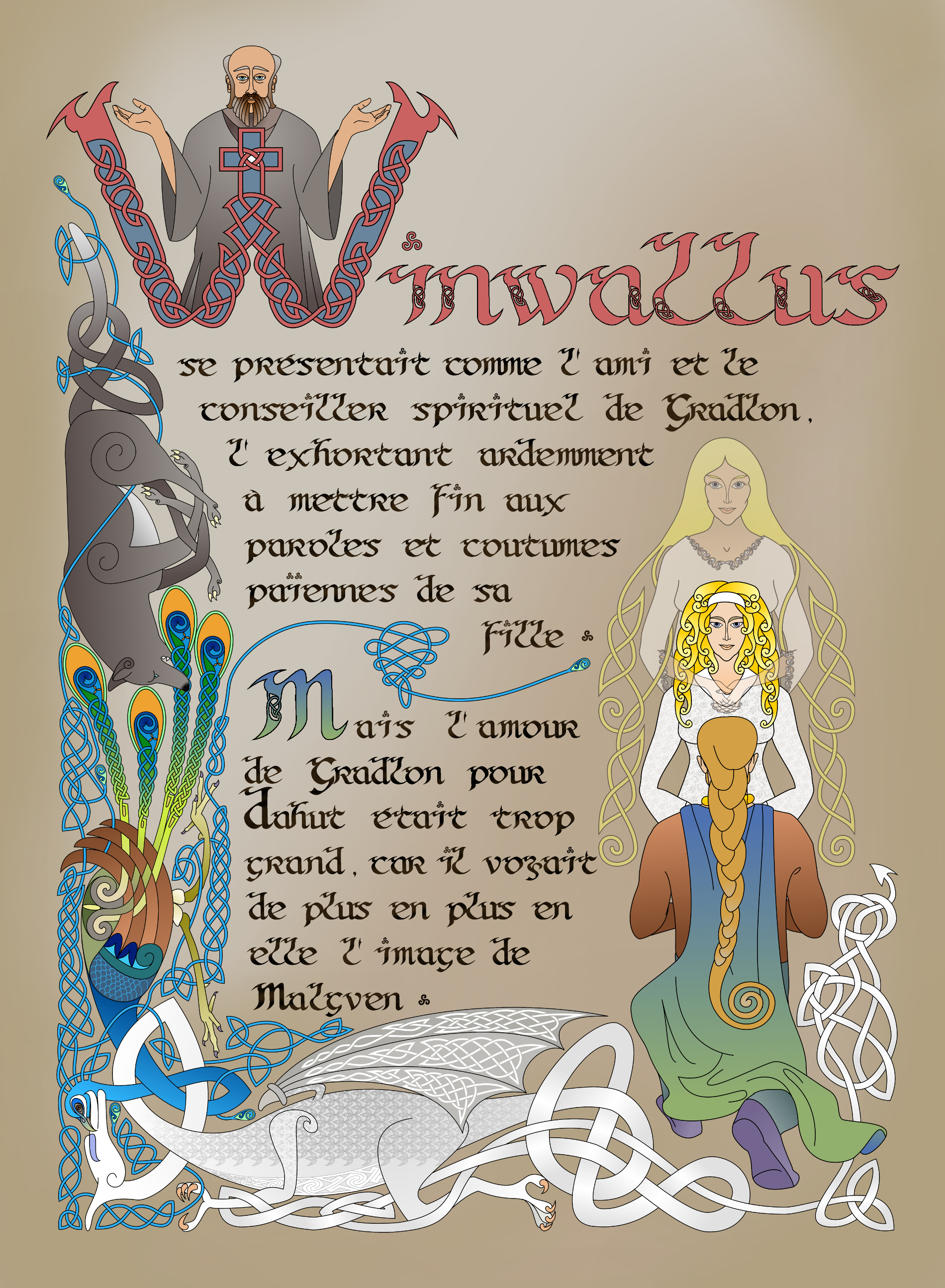fol. 11r
Winwallus se présentait comme l'ami et le conseiller spirituel de Gradlon, l'exhortant ardemment à mettre fin aux paroles et coutumes païennes de sa fille.
Mais l'amour de Gradlon pour Dahut était trop grand, car il voyait de plus en plus en elle l'image de Malgven(1).
(1) Dans le mythe original, la mère de Dahut n'est pas mentionnée.
On dit généralement que la figure de Malgven en tant que mère de Dahut a été inventée par Charles Guyot dans son roman de 1926, "La Légende de la ville d'Ys d'après les anciens textes".
Mais une beaucoup plus ancienne mention de Malgven date de 1891, dans l'article (témoignant d'un certain esprit du temps...) «Les légendes de la Bretagne et le génie celtique» d'Édouard Schuré, publié dans «Revue des deux mondes», n ° 106, juillet 1891, p. 422-423:
"La légende de la ville d'Ys est l'echo de l'Armorique païenne du IVe et du Ve siècle. On y sent passer comme un ouragan la terreur des vieux cultes païens et celle de la passion des sens déchainée dans la femme. A ces deux terreurs s'en mêle une troisième, c'est celle de l'Océan.
Le paganisme, la femme et l'Océan, ces trois désirs et ces trois peurs de l'homme, se combinent dans cette singulière tradition et finissent en une tempête d'épouvante.
...
Non moins redoutable et belle était la reine du Nord, ...
De quel exploit, de quel crime ou de quelle trahison cette proie splendide était-elle le prix? On disait que Malgven était une magicienne, une sène irlandaise ou une saga scandinave qui avait fait périr son premier possesseur par le poison, pour suivre le chef armoricain.
Mais à peine celui-ci fût-il devenu roi de Cornouailles, que Malgven mourut subitement, ne laissant au roi qu'une fille née en mer pendant leurs aventures, et qui s'appelait Dahut.
...
Elle seule avait le don d'égayer Gradlon. En la regardant, il croyait revoir Malgven."
fol. 11r
Winwallus presented himself as Gradlon's friend and spiritual advisor, urging him earnestly to end his daughter's pagan words and customs.
But Gradlon's love for Dahut was too great, for he saw in her more and more the image of Malgven(1).
(1) In the original myth, Dahut's mother is not mentioned.
It is generally said that the figure of Malgven as the mother of Dahut was invented by Charles Guyot in his 1926 novel, "La Légende de la ville d'Ys d'après les anciens textes" (The Legend of the City of Ys following the old texts).
But a much older mention of Malgven dates from 1891, in the article (testifying to a certain zeitgeist ...) “Les légendes de la Bretagne et le génie celtique” (The legends of Brittany and the Celtic genius) by Édouard Schuré, published in “Revue des deux mondes” , n ° 106, July 1891, p. 422-423:
"The legend of the town of Ys echoes pagan Armorica from the 4th and 5th centuries. One feels there pass like a hurricane the terror of the old pagan cults and that of the passion of the senses unleashed in woman. A third is mixed with these two terrors, that of the Ocean.
Paganism, woman and the ocean, these three desires and these three fears of man, combine in this singular tradition and end in a storm of terror.
...
No less formidable and beautiful was the queen of the North, ...
Of what exploit, what crime or what treason was this splendid prey the price? It was said that Malgven was a magician, an Irish sene or a Scandinavian saga who had killed her first possessor by poison, to follow the Armorican chief.
But no sooner had he become King of Cornwall, when Malgven died suddenly, leaving the King only a girl born at sea during their adventures, and who was called Dahut.
...
She alone had the gift of brightening up Gradlon. Looking at her, he thought he saw Malgven again."
Cliquez l'image pour une meilleure qualité.
Click on the picture for a better quality.

